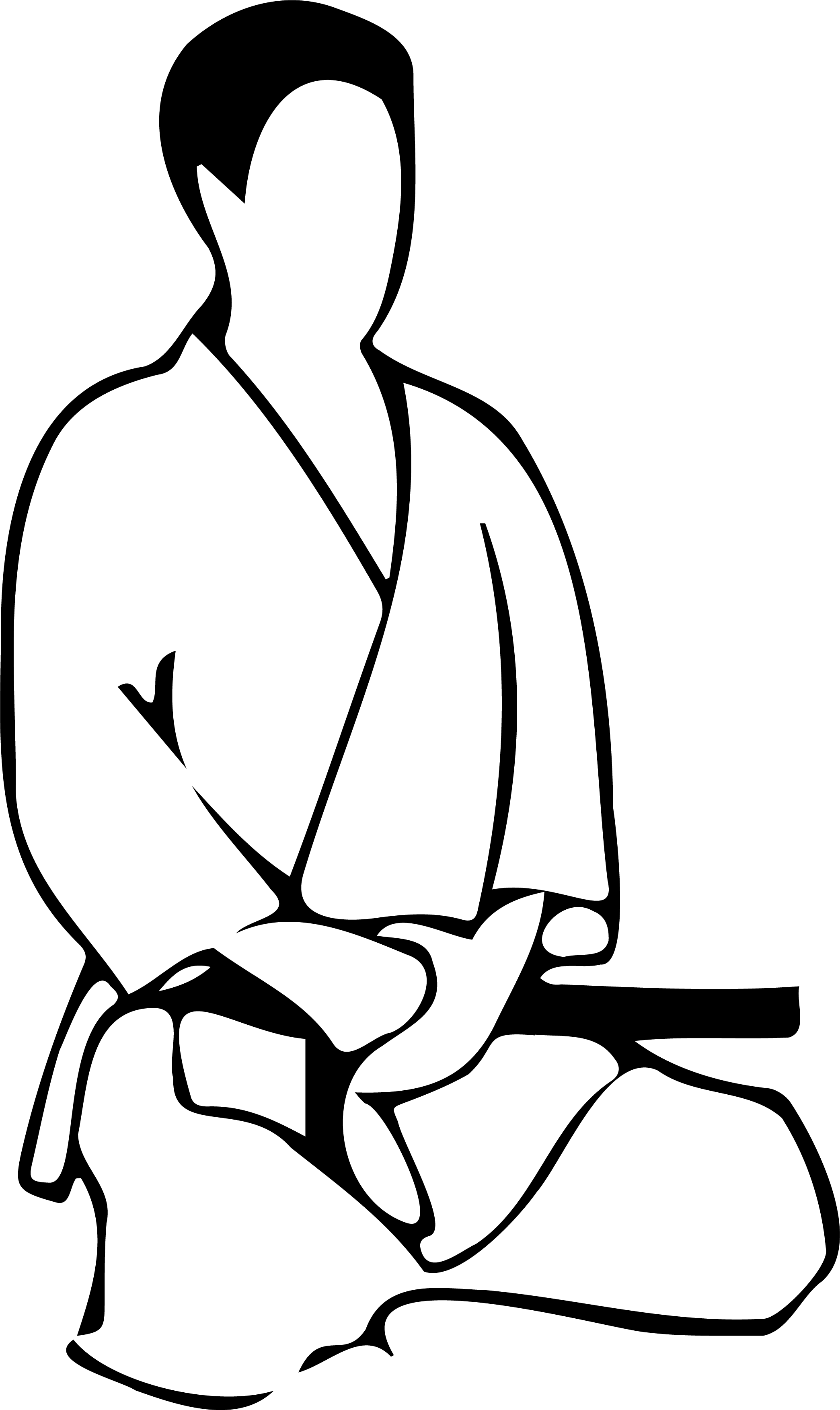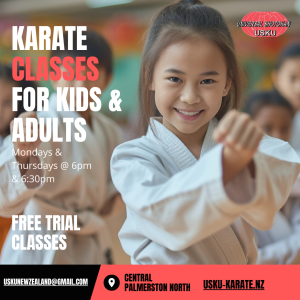
Classes
Class Times
Monday and Thursday
6 pm – 6:30 pm | Kids | A half-hour class dedicated to kids from age 8 and above. |
6:30pm – 7:30 pm | Adults & Teens | An hour-long class for beginners (white & yellow belts) and intermediates (green & blue belts). |
6:30 pm – 8 pm | Advanced | An hour and a half of training for the advanced (brown & black belts). |
We invite you to come along to a few training sessions at the dojo and give Shotokan Karate a try.
Places are limited – so booking is essential.

Training Locations
Mondays
Loft Dance studio
Square Edge (entry via Jersey Lane)
Palmerston North, 4410
Thursdays
Hokowhitu School Hall
227 Albert Street
Palmerston North, 4410

2025
Term Dates
Term 1 | Monday 3 February – Friday 11 April 2025 | |
Term 2 | Monday 28 April – Friday 27 June 2025 | |
Term 3 | Monday 14 July – Friday 19 September 2025 | |
Term 4 | Monday 6 October – Thursday 11 December 2025 | Note: There is no training on public holidays. |
Training Sessions
A typical class starts with a formal line up ritual followed by warm-up exercises. The training is comprised of three elements: Kihon (basics), Kumite (sparring), and Kata (forms). Students are expected to follow the dojo kun throughout class. Parents are encouraged to remain and observe during the kids’ class.
Kihon
Initially, basic moves that form the foundation of Shotokan Karate are taught. Basics are the techniques of blocking, punching, and kicking. Balancing and body shifting are other important techniques that are a part of body movement or basics.
Beginners are taught simple techniques first. They practice the same technique numerous times in a slow manner until the technique becomes natural. Eventually, the students will learn more sophisticated techniques and combinations to improve their attacking and defending skills.
Learning the basic techniques is like building a house; the more solid the foundation one has, the stronger the building becomes. Likewise with karate, if you learn strong basic techniques then your karate will become better and stronger.
Kumite
A portion of one’s karate training involves working with partners in class. This exercise is called Kumite.
The objective of working with a training partner is to learn the applications of the basic techniques in distancing and timing, in a controlled environment.
All kumite (sparring) is closely monitored and managed by the instructor/s and, in order to avoid injuries, only light body contact is allowed (no head contact), i.e. blocking and minimal contact with a chudan (stomach mid area) zuki (punch).
For more advanced sparring we use gloves, mouth guards, and some other protective gear. Wearing protective gear is a requirement for anyone that wants to participate in local, national, and international tournaments.
Kata
In addition to the basic punching, kicking and blocking techniques used in kumite (sparring), kata training is also practiced. Kata training is the performance of a prescribed series of karate moves designed to teach combination techniques in a mock fight against multiple attackers with and without weapons.
There are 26 different Kata in the USKU syllabus, but a beginner will practice only the first five or six in the first couple years of training. A typical beginner Kata has between 20 and 29 moves. For the Shodan (first degree black belt) examination, a student is required to know at least 10 different Kata. Senior black belts will continue to learn up to 26 Kata.
Beginner FAQs
-
Can I watch a lesson before starting?
You are welcome to observe a class before joining in. Contact us.
-
What should I wear for my first lesson/s?
For your first few lessons, it is fine to wear track pants/shorts and a T-shirt.
We train barefoot, so no footwear is necessary.
-
What should I bring to my first lesson/s?
It is advisable to bring a drink and a sweat towel to lessons.
-
How much does a gi (uniform) cost?
Once you join USKU, you will need a gi (karate uniform) gi. Costs of gis (uniforms) vary according to size and weight. Adult uniforms start at around $40 and kids’ start at around $35. But we have some available to loan to new students.
-
Do I need to be fit?
Having a good overall level of fitness is an advantage, but not a necessity. Regular and diligent karate training will help improve your cardiovascular fitness, flexibility, balance, muscular endurance, and strength. If you are not in the habit of exercising, then consult a doctor before commencing a new exercise programme.
-
What can I expect at training (adults/teenagers)?
A typical adult class starts with a formal line up ritual followed by a warm-up. The training is comprised of three elements: Kihon (basics), Kumite (sparring), and Kata (forms) – see below for further details. The class ends with some light stretching and a second formal line up ritual.
-
What can I expect at training (kids)?
A typical kids class starts with a formal line up ritual followed by a warm-up game. The training is comprised of three elements: Kihon (basics), Kumite (sparring), and Kata (forms) – see below for further details. The class ends with a game and a second formal line up ritual. Parents are encouraged to remain and observe during the kids’ class.
-
How long does it take to get a black belt?
How long it takes will depend on how often and how diligently you train. It is possible to achieve black belt within four years, but many people take longer.
-
How often is grading?
Grading occurs when students are ready to grade (i.e. when they’ve made sufficient progress). Kids are usually invited to grade 1-2 times a year. Adults and teens are usually invited grade 2-3 times a year for kyu (coloured belt) grades.
Note: To be invited to grade, students must: 1) demonstrate commitment to training; 2) make sufficient progress; 3) meet the attendance requirement (a record of attendance will be kept). Students who do not meet the attendance requirement will not be invited to grade.
-
Do students have to compete in tournaments?
There are opportunities to compete in tournaments, but competing is not required.
Dojo Kun
The Dojo Kun, literally translated means the Dojo rules (a set of training hall rules that are common to most martial arts). The five Shotokan karate Dojo Kun provide a set of guiding principles that are expected of karateka both inside and outside the Dojo. Below are the Japanese Dojo Kun and their respective translations:
Hitotsu! Jinkaku kansei ni tsutomurukoto
Each person must strive for the perfection of one’s character.
Hitotsu! Makoto no michi wo mamorukoto
Each person must be faithful and protect the way of truth.
Hitotsu! Doryoku no seishin wo yashinakoto
Each person must endeavour (fostering the spirit of effort).
Hitotsu! Reigi wo omonzurukoto
Each person must respect others and the rules of etiquette.
Hitotsu! Keki no yu o imashimuru koto
Each person must refrain from violent behaviour (guard against impetuous courage).
Intra-Dojo Tournaments
We sometimes run intra-dojo tournaments (usually at the end of a term or in the run up to a competition). Students have the opportunity to compete in kata and/or kumite. Intra-dojo competitions are small and friendly. They provide experience of competing and promote healthy competition between students.